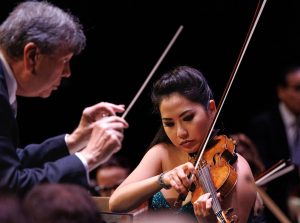
By Dennis Rooney
The Nov. 6 concert by the Palm Beach Symphony at the Kravis Center was the opening of the orchestra’s 49th season. Music director Gerard Schwarz was on the podium and violinist Sarah Chang was the soloist.
The first work on the program was the afternoon’s best performance; an alert and sprightly account of Rounds for String Orchestra by David Diamond. Known for his morose, sometimes peevish personality, Diamond (1915-2005) confounded those qualities in this work, commissioned by Dimitri Mitropoulos in 1944, when he was conductor of the Minneapolis Symphony Orchestra.
An apostle of modernism, Mitropoulos encountered strong audience resistance to the frequent new works that appeared on his Minneapolis programs. In the midst of World War II, he needed a new American work that would please his audience. When he commissioned Diamond, he wrote: “These are distressing times. Most of the difficult music I play is distressing. Make me happy.” The three-movement work that resulted became Diamond’s best-known work.
One of the easiest forms of part singing, a round is a type of canon in which at least three voices repeat the same melody in unison at different times to produce a harmonious result. “Row, row, row your boat” is such a round. But Diamond makes use of many more contrapuntal devices in the course of the work that listeners would not necessarily comprehend. The work has a vivacity and moments of gaiety that have earned it a secure place in the repertoire. Schwarz has recorded both this work and the composer’s symphonies, and the performance suitably showcased the orchestra’s string choirs.
Sarah Chang, soon to turn 42, has a long acquaintance with the Violin Concerto No. 1 (in G minor, Op. 26) by Max Bruch. It was the piece she played for her Juilliard audition at the age of 5. She has recorded it with the late conductor Kurt Masur.
It was, therefore, a surprise to hear her tonally drab and tentative entrance in the quasi-improvisational Vorspiel and the ensuing Allegro moderato. She struggled with imperfect intonation, especially on the lower strings, and at times was hard to hear against the orchestra. Dreyfoos Hall, in my experience, is not friendly to string soloists. Her inability to meaningfully phrase the cantabile of the Adagio middle movement detracted from that movement’s place as the work’s emotional anchor, and unbalanced its structural architecture.
The Allegro energico finale offered our only glimpse of a major soloist, who suddenly played with solid pitch, rhythmic excitement, and sporadically successful bravura episodes. The entire performance suggested a sharpness and alertness that probably originated from some excellent coaching. Even the orchestra played with better articulation and rhythmic precision than they had in the preceding movements.
The second half presented the Symphony No. 2 (in D, Op. 73) by Johannes Brahms, which according to the program booklet, was the Palm Beach Symphony’s first performance of it. Schwarz seems at his best in music of rhythmic and textural complexity. So, the Trio of the third movement and much of the finale were superior to the first two movements, which were rather shapeless, mostly on account of sloppy entrances, poor articulation, and orchestral balance.
Schwarz busily gave cues to the winds and brass, but it never translated into more secure ensemble or improved phrasing, and the violins seemed consistently undervalued. One heard all the notes, but not in a way that produced much pleasure. Superfluous prefatory remarks were a further drag on the afternoon.